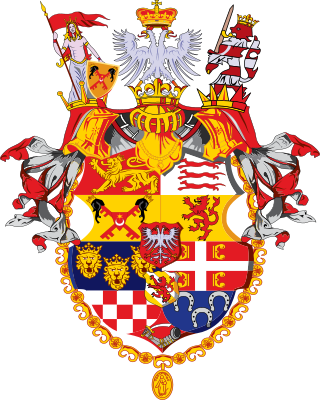Illyrian armorials
From Wikipedia, the free encyclopedia
The Illyrian Armorials (Serbian: Ilirski grbovnici) are a group of armorials compiled from mainly fictional medieval coats of arms, among which there can be found several actual coats of arms, during the late 16th to mid 18th century. They are all copies based on alleged lost original of the Ohmučević Armorial (Ohmučevićev grbovnik), commissioned by Petar Ohmučević (died 1599), a person of Ragusan origin, who went to become an admiral of Spanish court and navy at some point between 1584 and 1594. It is an example of the earliest ("Interconfessional") form of Illyrism idea and notion of so-called "Illyrian Empire", which formed the ideological basis for both the later rise of nationalism in the Balkans among its South Slavs, and the idea of unification into one state that in later times took a form of Yugoslavia.

The armorials combine historical (late medieval) with fictional coats of arms to construct the notion of an "Illyrian Empire". This fictional Empire happened to coincide exactly with the sphere of interest of the Spanish Empire in the Balkans at the time, and hence also Petar's own. Petar Ohmučević personal goal was to confirm his own "Illyrian" noble origins, after he rose to the rank of admiral in the Spanish navy, and in order to qualify for the greater chivalric orders of Habsburg Spain at the time, for which was necessary to prove descent from eight noble and purely Catholic great-grandparents. Ohmučević was granted the status of nobleman in 1594, which is taken as the terminus ante quem of the armorial.
Some believe that it is an attributed arms of the Serbian Empire, because the creation itself is often signed as the insignia of Emperor Dusan (Imperatoris Stephani Stephani Nemagnich Insignia, etc.)
Ohmučević's armorial can thus be considered a personal project in inventing and probing one's origin, or even a hoax, as he invented genealogy in order to defraud a Spanish court and qualify for the coveted title. However, its immense influence in becoming the foundation of South Slavic or "Illyrist" heraldry in general, can't be denied. An important source for Ohmučević's heraldic inventions was the Wappenbüchlein by Virgil Solis (1555), which itself contains fictional arms of "foreign kingdoms".
The Illyrian Armorials includes the following armorials, with estimated dates in brackets:
| Armorial | Date | Description |
|---|---|---|
| Ohmučević Armorial [sr] (Ohmučevićev grbovnik) |
1584–94 | |
| Belgrade Armorial II (Beogradski grbovnik II) |
1574–1603 | in Latin, one of the oldest and finest of the Illyrian Armorials.[1] |
| Korjenić-Neorić Armorial (grbovnik Korjenića-Neorića) |
1595 | in Slavic (Cyrillic) and Latin.[2] |
| Tasovčić Armorial (Tasovčićev grbovnik) |
1596–1623 | |
| Berlin Armorial (Berlinski grbovnik) |
||
| Palinić Armorial (Palinićev grbovnik) |
end of 16th, beginning of 17th | in Slavic (Cyrillic) and Latin |
| Althann Armorial (Altanov grbovnik) |
1614 | based on an older armorial, copied in Vienna, made for Austrian feldmarschall Althann.[3] |
| London Armorial (Londonski grbovnik) |
1637 | |
| Skorojević Armorial (Skorojevićev grbovnik) |
1633 | in Latin, based on Altan Armorial.[4] |
| Fojnica Armorial (Fojnički grbovnik) |
1675 | made for the younger branch of the Ohmučević for Austrian nobility status.[5] |
| Split Armorial (Splitski grbovnik) |
1740 | |
| Kevešić Armorial (Kevešićev grbovnik) |
1740 | in Latin.[6] |
| Saraka Armorial (Sarakin grbovnik) |
1746 | in Latin, made by Ragusan Miho Pešić for 'P. M. P'.[6] |
| Olovo Armorial (Olovski grbovnik) |
end of 17th | in Latin, uncoloured, copy of the Korenić-Neorić Armorial, likely by Ivan Benigni.[7] |
| Vukoslavić Armorial (Vukoslavićev grbovnik) |
1700 | in Latin, likely copied along with the Olovo Armorial, made for the Split clergyman Petar Vukoslavić.[8] |
| Pašković Armorial (Paškovićev grbovnik) |
1820–25 | [9] |
| Festetić Armorial (Festetićev grbovnik) |
1837 | in Latin, copy of the Ohmučević Armorial.[10] |
| Šafarik Armorial (Šafarikov grbovnik) |
1845 | in Cyrillic, copy of the Fojnica Armorial, made for Janko Šafarik.[10] |
| Pašalić Armorial (Pašalićev grbovnik) |
1842 | good copy of Fojnica Armorial, made by Filip Pašalić for Ljudevit Gaj.[11] |
See also
Wikimedia Commons has media related to Illyrian Armorials.
References
Bibliography
Wikiwand - on
Seamless Wikipedia browsing. On steroids.
